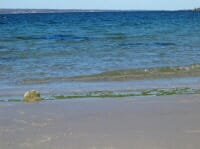
A prime example of aquaculture conflict can be witnessed on the scenic South Shore of Nova Scotia at Port Mouton Bay. This was once a happy area for fishermen, boasting a wealth of lobsters, clams, scallops and bait-fish. The area was also a favorite with divers and tourists for its quaint charms and biodiversity, but in 1994 fishermen began finding green slime creeping up the beaches. Little did they know at the time what trouble this slime would bring.
The issue became progressively more problematic in each of the 14 years since it was identified, fouling up fishing gear and rotting on the beaches. Meanwhile, the biodiversity of species fell into decline until populations of lobster, bait-fish, scallops, clams and mussels became seriously diminished, or in some case, no longer present.
Since then some of the once-lucrative waters have been starved of oxygen transforming into dead zones, but at least the fishermen have a culprit. Unfortunately for the fish farm operation that shares these waters, the finger of blame points at them.
So heated has the debate become that their now stands a coalition of over 1,500 lobster fishermen in opposition of the farm. They call themselves the Friends of Port Mourton Bay and they believe that "the future of the Bay lies in tourism and the commercial wild catch fishery". According to FPMB, these goals both depend on a healthy, clean marine environment.
Yet, despite of mounting aggression from the FPMB an application for a second, even larger, salmon fish farm in the Bay has been submitted to the Province. Many members of the FPMB believe that this proposal will get federal approval in an assessment expected in March. "The proposed open netcage salmon farm is not compatible with this vision," some say, others predict disaster.
This is just one case in many where the fish farming has managed to alienate itself against the local community. Large aquaculture operations such as this are often seen by locals as modern corporate bullies who pit themselves in opposition of the traditional fishermen. The commercial fishery, especially lobster, and tourism are the primary sources of work in the area. It is easy to see why communities like that of Port Mourton Bay feel anger towards such companies when evidence of their negative impacts keep mounting.
"The aquaculture site at Spectacle Island has been a failure in terms of its ecological footprint which extends over the greater part of inner Port Mouton Bay", says am FPMB report. The report claims that sediment monitoring at this site showed anoxic conditions in June 2004, significantly higher than any other finfish aquaculture site in Nova Scotia, and in June 2006, levels were even higher than in 2004.
* "Nuisance algae thrive, and marine habitat is degraded by fish farms in Port Mouton Bay" |
|
Dr. Ron Loucks, Oceanographer
|
According to the FPMB, the ecological footprint of the aquaculture site greatly exceeds the boundaries of its lease. Consequently, fishermen have been forced to abandon the inner harbour because of the 'dead' zone created by the fish farm. It has been estimated that up to 600 lobster traps have been displaced and many believe that the latest expansion will end their ability to fish in the area altogether.
In retaliation of these claims are the beliefs that lobsters like fish farms and want to be near them, but local fishermen say they have found the opposite to be true. It has also been argued that waste from fish plants in the Bay has caused the decline to inner harbour fisheries.
Here, the FPMB say that fish plants have operated in the Bay for decades with no harm to the fishery. They say that solid fish waste is removed from the site and add that the decline in the inner harbour fishery coincides with the timeline of the fish farm operation.
The amount of harmful nutrients released by the existing farm at a 200,000 fish stocking capacity are equivalent to 5,000 persons; the proposed expansion would release nutrients equivalent to 10,000 persons (approximately equivalent to the entire population of Queens County) at a stocking capacity of 600,000.
The FPMB says that it is this huge amount of waste that contaminates the surrounding waters and causes problems for the natural ecosystem and - consequently - the fishermen. They add that there are serious issues with the location of the site that have magnified these harmful affects. In this part of the bay water only re-circulates, but to cleanse itself of contamination it must flush. This means that the waste is unable to escape into the sea and finds itself endlessly mounting in a circulating area.
"All of the scientific experiments we conducted proved the fishermen are absolutely correct," says Dr. Ron Loucks, Oceanographer. "Nuisance algae thrive, and marine habitat is degraded by fish farms in Port Mouton Bay. Low flushing rate is deemed to be at the root of the problems."
There are always going to be negative side affects with the pollution of off-shore fish farms, but these effects can be reduced with good management and well planned site location. Whilst evidence against the fish farms at Port Mourton Bay remain uncertain, it is true to say that they are not yet welcome. Incidence of conflicting aquaculture operations gain huge media coverage, putting the argument to a much wider audience. No longer is it just the fish farm at Port Mourton bay which falls under scrutiny, it is fish farms all over Nova Scotia, Canada and the rest of the world.
March 2009




